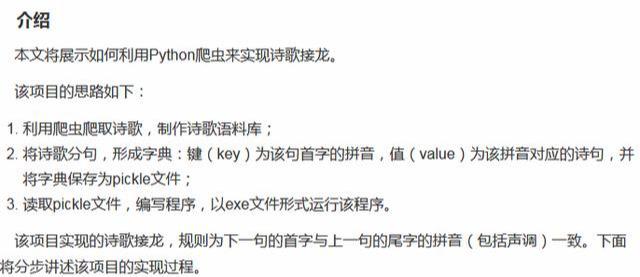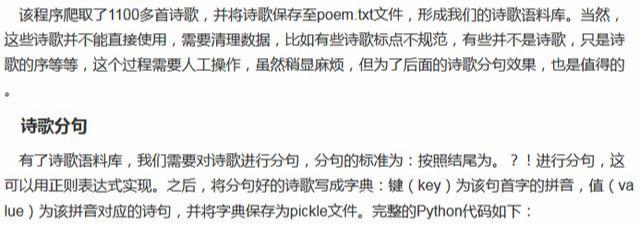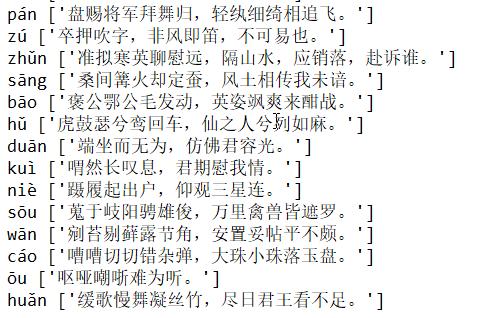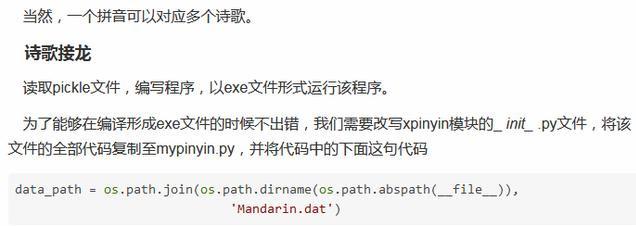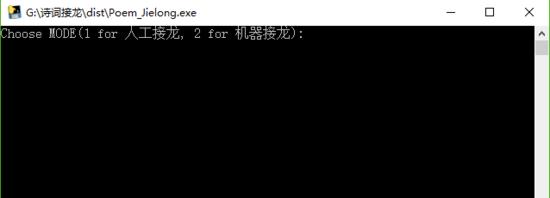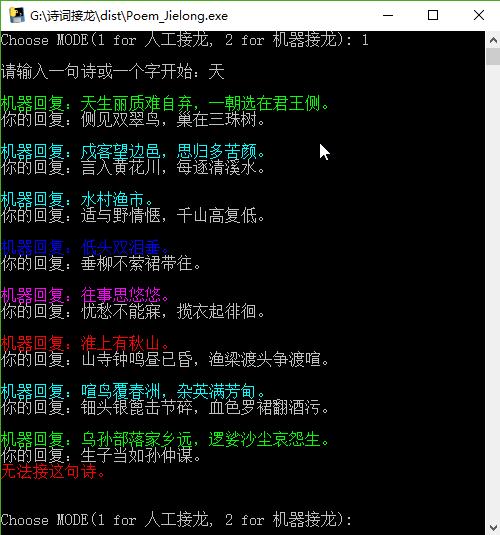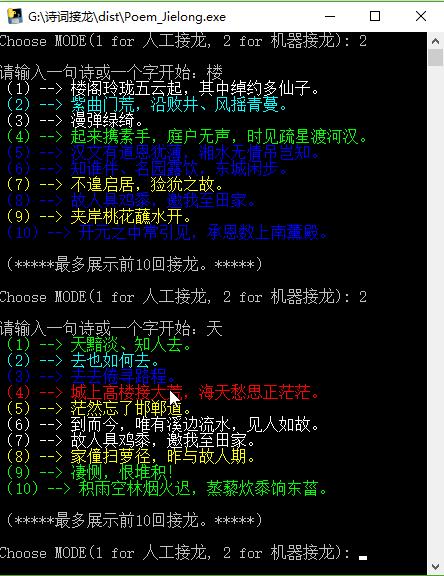利用Python寫了個成語接龍!我弟弟已經玩了三天了!還是玩不過!
阿新 • • 發佈:2018-12-28
詩歌語料庫
首先,我們利用Python爬蟲來爬取詩歌,製作語料庫。爬取的網址為: https://www.gushiwen.org,頁面如下 :
由於本文主要為試了展示該專案的思路,因此,只爬取了該頁面中的唐詩三百首、古詩三百、宋詞三百、宋詞精選,一共大約1100多首詩歌。為了加速爬蟲,採用併發實現爬蟲,並儲存到poem.txt檔案。完整的Python程式如下:
import re
import requests
from bs4 import BeautifulSoup
from concurrent.futures import ThreadPoolExecutor, wait, ALL_COMPLETED
# 爬取的詩歌網址
urls = ['https://so.gushiwen.org/gushi/tangshi.aspx',
'https://so.gushiwen.org/gushi/sanbai.aspx',
'https://so.gushiwen.org/gushi/songsan.aspx',
'https://so.gushiwen.org/gushi/songci.aspx'
]
poem_links = []
# 詩歌的網址
for url in urls:
# 請求頭部
headers = {'User-Agent': 'Mozilla/5.0 (Windows NT 10.0; WOW64) AppleWebKit/537.36 (KHTML, like Gecko) Chrome/67.0.3396.87 Safari/537.36'}
req = requests.get(url, headers=headers)
soup = BeautifulSoup(req.text, "lxml")
content = soup.find_all('div', class_="sons")[0]
links = content.find_all('a')
for link in links:
poem_links.append('https://so.gushiwen.org'+link['href'])
poem_list = []
# 爬取詩歌頁面
def get_poem(url):
#url = 'https://so.gushiwen.org/shiwenv_45c396367f59.aspx'
# 請求頭部
headers = {'User-Agent': 'Mozilla/5.0 (Windows NT 10.0; WOW64) AppleWebKit/537.36 (KHTML, like Gecko) Chrome/67.0.3396.87 Safari/537.36'}
req = requests.get(url, headers=headers)
soup = BeautifulSoup(req.text, "lxml")
poem = soup.find('div', class_='contson').text.strip()
poem = poem.replace(' ', '')
poem = re.sub(re.compile(r"([sS]*?)"), '', poem)
poem = re.sub(re.compile(r"([sS]*?)"), '', poem)
poem = re.sub(re.compile(r"。([sS]*?)"), '', poem)
poem = poem.replace('!', '!').replace('?', '?')
poem_list.append(poem)
# 利用併發爬取
executor = ThreadPoolExecutor(max_workers=10) # 可以自己調整max_workers,即執行緒的個數
# submit()的引數: 第一個為函式, 之後為該函式的傳入引數,允許有多個
future_tasks = [executor.submit(get_poem, url) for url in poem_links]
# 等待所有的執行緒完成,才進入後續的執行
wait(future_tasks, return_when=ALL_COMPLETED)
# 將爬取的詩句寫入txt檔案
poems = list(set(poem_list))
poems = sorted(poems, key=lambda x:len(x))
for poem in poems:
poem = poem.replace('《','').replace('》','')
.replace(':', '').replace('“', '')
print(poem)
with open('F://poem.txt', 'a') as f:
f.write(poem)
f.write('
')
私信小編001獲取精心準備的教程大禮包,入門很簡單!
import re
import pickle
from xpinyin import Pinyin
from collections import defaultdict
def main():
with open('F://poem.txt', 'r') as f:
poems = f.readlines()
sents = []
for poem in poems:
parts = re.findall(r'[sS]*?[。?!]', poem.strip())
for part in parts:
if len(part) >= 5:
sents.append(part)
poem_dict = defaultdict(list)
for sent in sents:
print(part)
head = Pinyin().get_pinyin(sent, tone_marks='marks', splitter=' ').split()[0]
poem_dict[head].append(sent)
with open('./poemDict.pk', 'wb') as f:
pickle.dump(poem_dict, f)
main()
我們可以看一下該pickle檔案(poemDict.pk)的內容:
改寫為
data_path = os.path.join(os.getcwd(), 'Mandarin.dat')
這樣我們就完成了mypinyin.py檔案。
接下來,我們需要編寫詩歌接龍的程式碼(Poem_Jielong.py),完整程式碼如下:
import pickle
from mypinyin import Pinyin
import random
import ctypes
STD_INPUT_HANDLE = -10
STD_OUTPUT_HANDLE = -11
STD_ERROR_HANDLE = -12
FOREGROUND_DARKWHITE = 0x07 # 暗白色
FOREGROUND_BLUE = 0x09 # 藍色
FOREGROUND_GREEN = 0x0a # 綠色
FOREGROUND_SKYBLUE = 0x0b # 天藍色
FOREGROUND_RED = 0x0c # 紅色
FOREGROUND_PINK = 0x0d # 粉紅色
FOREGROUND_YELLOW = 0x0e # 黃色
FOREGROUND_WHITE = 0x0f # 白色
std_out_handle = ctypes.windll.kernel32.GetStdHandle(STD_OUTPUT_HANDLE)
# 設定CMD文字顏色
def set_cmd_text_color(color, handle=std_out_handle):
Bool = ctypes.windll.kernel32.SetConsoleTextAttribute(handle, color)
return Bool
# 重置文字顏色為暗白色
def resetColor():
set_cmd_text_color(FOREGROUND_DARKWHITE)
# 在CMD中以指定顏色輸出文字
def cprint(mess, color):
color_dict = {
'藍色': FOREGROUND_BLUE,
'綠色': FOREGROUND_GREEN,
'天藍色': FOREGROUND_SKYBLUE,
'紅色': FOREGROUND_RED,
'粉紅色': FOREGROUND_PINK,
'黃色': FOREGROUND_YELLOW,
'白色': FOREGROUND_WHITE
}
set_cmd_text_color(color_dict[color])
print(mess)
resetColor()
color_list = ['藍色','綠色','天藍色','紅色','粉紅色','黃色','白色']
# 獲取字典
with open('./poemDict.pk', 'rb') as f:
poem_dict = pickle.load(f)
#for key, value in poem_dict.items():
#print(key, value)
MODE = str(input('Choose MODE(1 for 人工接龍, 2 for 機器接龍): '))
while True:
try:
if MODE == '1':
enter = str(input('
請輸入一句詩或一個字開始:'))
while enter != 'exit':
test = Pinyin().get_pinyin(enter, tone_marks='marks', splitter=' ')
tail = test.split()[-1]
if tail not in poem_dict.keys():
cprint('無法接這句詩。
', '紅色')
MODE = 0
break
else:
cprint('
機器回覆:%s'%random.sample(poem_dict[tail], 1)[0], random.sample(color_list, 1)[0])
enter = str(input('你的回覆:'))[:-1]
MODE = 0
if MODE == '2':
enter = input('
請輸入一句詩或一個字開始:')
for i in range(10):
test = Pinyin().get_pinyin(enter, tone_marks='marks', splitter=' ')
tail = test.split()[-1]
if tail not in poem_dict.keys():
cprint('------>無法接下去了啦...', '紅色')
MODE = 0
break
else:
answer = random.sample(poem_dict[tail], 1)[0]
cprint('(%d)--> %s' % (i+1, answer), random.sample(color_list, 1)[0])
enter = answer[:-1]
print('
(*****最多展示前10回接龍。*****)')
MODE = 0
except Exception as err:
print(err)
finally:
if MODE not in ['1','2']:
MODE = str(input('
Choose MODE(1 for 人工接龍, 2 for 機器接龍): '))
現在整個專案的結構如下(Mandarin.dat檔案從xpinyin模組對應的資料夾下複製過來):
切換至該資料夾,輸入以下命令即可生成exe檔案:
pyinstaller -F Poem_jielong.py
生成的exe檔案為Poem_jielong.exe,位於該資料夾的dist資料夾下。為了能夠讓exe成功執行,需要將poemDict.pk和Mandarin.dat檔案複製到dist資料夾下。
測試執行
執行Poem_jielong.exe檔案,頁面如下:
本專案的詩歌接龍有兩種模式,一種為人工接龍,就是你先輸入一句詩或一個字,然後就是計算機回覆一句,你回覆一句,負責詩歌接龍的規則;另一種模式為機器接龍,就是你先輸入一句詩或一個字,機器會自動輸出後面的接龍詩句(最多10個)。
先測試人工接龍模式:
再測試機器接龍模式:
原始碼小編已經打包了,進群:960410445 下載即可!

